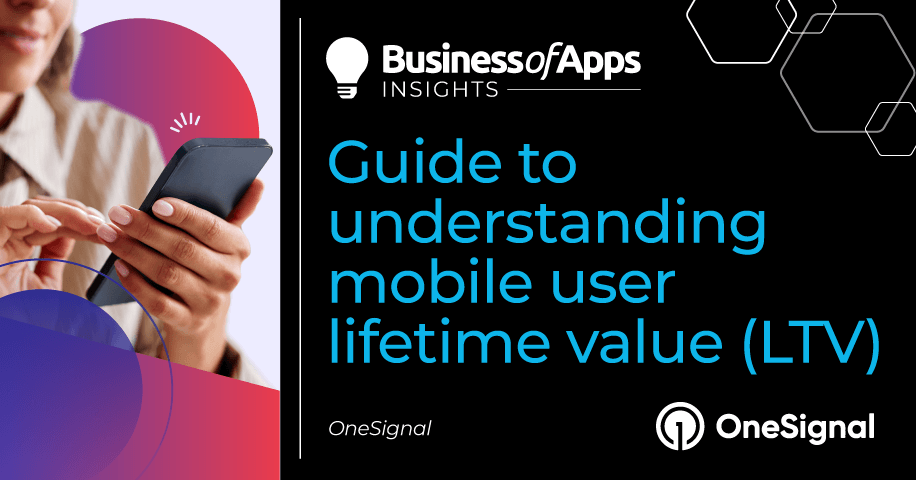Users are the lifeblood of your app. Their behavior (use-frequency, engagement, purchases) drives the bulk of your revenue and determines long-term success or failure. But user behavior can often be unpredictable and unreliable.
Mobile user lifetime value (LTV) is a metric used to assign value to a new user of your app and an indispensable data point to adopt (or abandon) important marketing strategies.
In other words, if users are your lifeblood, LTV is effectively a way to run bloodwork and illuminate the vitality and longevity of your user base. If it sounds like potentially one of the most important marketing metrics to have on your radar… that’s because it is.
This post was first published on onesignal.com.
What is LTV?
LTV, or user lifetime value, describes how much revenue a user generates for your business over the entire duration of their relationship with your app.
As far as metrics used to measure the success of your mobile app go, LTV should be your North Star. This value not only helps marketers identify high-quality users who are driving profit over their acquisition cost, but also contributes a quantifiable number to the broader performance of your mobile marketing strategy such as user loyalty benchmarks, growth forecasting, and overall app success.
What are high-quality users?
High-quality users are users who visit your app often, frequently engage with app features, and make purchases. If your total user base is an indicator of your app’s health, high-quality users are the pure protein you want in your diet.
LTV is primarily a function of the following three variables. Below, we will walk you through exactly how to formulate these functions into a single, actionable number.
- Monetization – The amount of money a user contributes to your app revenue over their usage lifetime.
- Retention – The rate that users revisit or re-engage with your app over a specific timeframe.
- Virality – Your app’s “reach” or “shareability.” Simply put, virality describes how many new users your existing users will bring to your app.
Why does user LTV matter? – A wholistic metric for wholistic decisions
Managing a marketing budget, as you all know, is a game stuck somewhere between balancing 1,000 spinning plates and hitting 1,000 moving targets. Now more than ever, as user churn continues to plague mobile apps with low retention and immediate uninstalls, measuring marketing success is far from cut and dry. LTV solves this problem by telling you how much value a newly acquired user brings to your app – and by extension, gives you a cap for how much you should spend on acquisition costs.
Mobile app LTV should be the primary barometer for your mobile marketing budget because it effectively assigns weight to each and every user (or a user average), allowing marketers to identify the users most responsible for driving ROI.
Accuracy + Relevance = Success
According to Statista, 48% of mobile marketers said that their biggest marketing challenge was that new app installs don’t equate to high lifetime value (LTV) users. In fact, for many apps, an “install” is virtually meaningless without a substantial return.
The cost to acquire an in-app buyer, as of 2021, was at an average of $74.68 in North America. Skyrocketing acquisition costs combined with a mobile marketing landscape in a constant state of change make determining user value an unpredictable process.
Companies that focus their marketing efforts on engaging and retaining high-quality users often see success in the following areas:
- Longer lifespan in app stores
- More likely to reach the top charts
- More likely to remain popular for longer periods of time
- Retain more loyal users who are less likely to switch to a competitor
- Generate sustained revenue growth over time
- Significantly more likely to be successful in the long term
In an industry where user churn and fragmentation are increasingly common, mobile marketers must remain focused and fiercely efficient. Leveraging mobile app LTV represents the difference between doing surgery with a chainsaw versus a scalpel.
How to calculate lifetime value
There are three ways to calculate LTV and arrive at a number you can use to accurately assign value to your users.
3 Ways to calculate LTV
Source: OneSignal
- Average monthly revenue per customer x Customer lifetime (in months)
- Average monthly revenue per customer / Monthly churn
- Average order value x Number of repeat sales x Average retention time (in months)
For example, your average user generates $2.30 per month and you have a monthly churn rate of 70%. Using Formula #2 ($2.30 / .70) we arrive at the value of $3.29, or your average user lifetime value. You also now know that you should not be paying more than $3.29 to acquire a new user.
How to improve LTV
There are several ways to boost mobile app LTV, most of which involve bolstering user retention, or how long (and often) users engage with your app. While user acquisition remains a pillar of mobile app marketing, optimizing user retention has proven time and time again to be a lower-cost and more sustainable strategy for driving consistent revenue. Calculating customer acquisition costs for mobile apps and improving mobile LTV are cornerstones of every profitable marketing plan.
Keep the following strategies in mind when looking for ways to increase mobile app user LTV:
Deep linking
App users are significantly more likely to subscribe and convert than mobile web users. Having a deep linking strategy in place prompts mobile web users to download your app from their device’s app store (or better yet, sends them straight into your app if they already have it downloaded), creating more intentional engagement and a seamless transition to app-exclusive features.
Multichannel messaging
Interactions with your mobile app are a two-way street. If you want to improve the value that your users bring to your business, you must be willing to build a trusted and consistent relationship with each and every one of them. Omnichannel messaging allows you to reach your users on multiple devices, personalize marketing efforts based on your target demography, and communicate with your audience in real-time – all of which are proven strategies that increase engagement.
For example, one targeted push notification sent to new users within the first week of app installation can boost retention rates by over 70%. The right mobile messaging provider can enable you to segment, automate, and analyze your mobile marketing strategy to significantly increase your LTV.
Social sharing
Social proof is indeed the backbone of virality and a key ingredient to improved user lifetime value. People spend nearly two and a half hours on social media every day. Maintaining a strong and frequent social media presence not only gives you a platform to promote promotional offers but also creates new engagement opportunities in social spaces where the right sticky messaging can spread like wildfire.
Design for the target audience
Whether you’re strategizing your next ad campaign or implementing new push notification flows, your mobile app must cater to the interests and preferred tone of voice of several specific demographics.
For example, push notifications, if done correctly, serve as an effective way to increase engagement, boost retention, and create loyal users whose lives are enriched by relevant messaging at the correct time. In essence, careful demographic targeting creates more high-quality users with higher mobile app LTV.
However, when implemented too broadly and without careful targeting, push notifications run the risk of alienating users by bombarding them with “spammy” messaging that clogs up their feeds with irrelevant information.
Remember, relevance and specificity breed loyalty.
Clarity
We can throw around terms like “user retention” and “churn rate” all day long, but if your mobile app does not provide a clear, consistently user-friendly experience, you can expect your app engagement (and user lifetime value) to flatline.
The user experience starts with onboarding – this is where new users will typically either struggle or soar when it comes to understanding your app’s UI. You have one shot at this, so make sure components like basic layout, setup instructions, and interactive preferences are all beginner-proof.
The user experience does not stop after someone has downloaded your app. In a world of identical-looking interfaces, features, and templated ads, is your app presenting itself in the best possible light? Which features help existing users on a day-to-day basis? Why should users rely on your platform over a competitor with comparable services?
It’s the difference between showing users your app and showcasing what your app can do for them.
Once you’ve dialed in your presentation, you can shift your focus to discounts and upselling to further drive interest.
Address pain points head on
A large part of marketing is communicating product updates to your customers and making them feel heard in the process. Do not shy away from common pain points users may be experiencing on your app. Address them directly with content designed to educate and alleviate customer challenges. Nurturing an open-dialogue relationship with your user base fosters long-term loyalty, encourages positive word-of-mouth on social media, increases retention, and most importantly shows your users that you’re listening to them.
Nurturing high-quality users with a high-quality messaging platform
Measuring the success of your mobile marketing campaigns can easily become a complex endeavor. With mobile LTV, marketers can distill data-driven user behavior into a single metric that quantifies the total value a user brings to their app. But gathering the data is just the first step. Leveraging a mobile messaging provider dedicated to elevating engagement and retention is one of the best ways to strengthen your mobile LTV. Now more than ever, customers expect personalized brand experiences across all of their devices. At OneSignal, we have the technology to implement these experiences quickly and in complete lockstep with your existing tech stack to help you scale with confidence.
OneSignal streamlines mobile messaging across all major marketing channels, including mobile/web push notifications, email, SMS, and in-app messaging. The OneSignal platform seamlessly integrates with your marketing stack to automate your mobile messaging strategy and dramatically boost user engagement, all without any developmental work on your end. Try OneSignal for free and see what happens when you truly harness your high-quality users!
Interested in discovering more tricks and tools to enhance your customer engagement strategy? We’d love to help!












